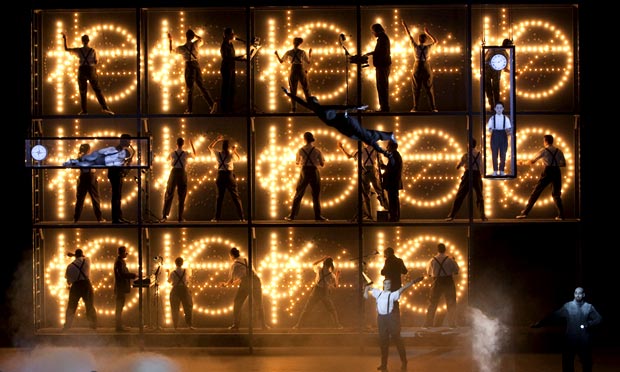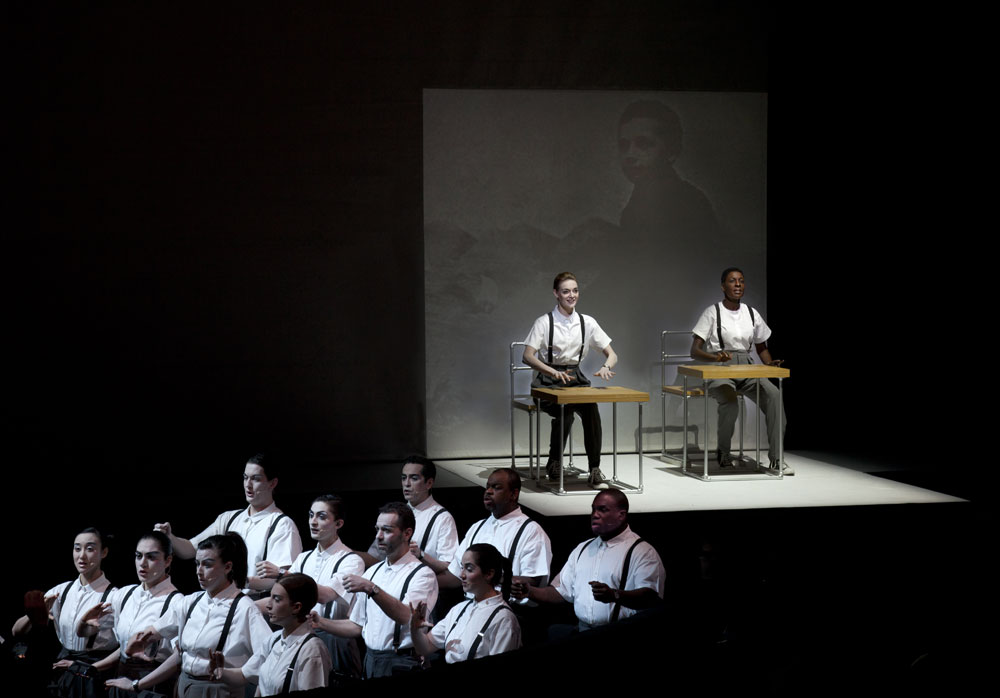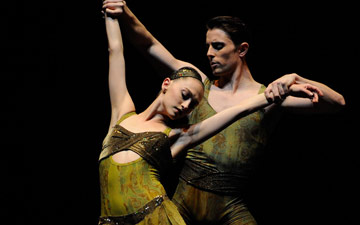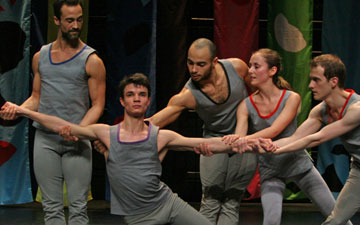
© Lesley Leslie-Spinks. (Click image for larger version)
Robert Wilson and Philip Glass
Einstein on the Beach
New York, Brooklyn Academy of Music
20 September 2012
pomegranatearts.com/project-einstein
www.bam.org
Singing us Into the Ground
The New York leg of the Philip Glass/Robert Wilson collaboration Einstein on the Beach revival has come and gone, leaving Big Questions in its wake: was it as good as the first time? Which elements have stood the test of time? Do four-and-a-half hours of minimalist “total theatre” still speak to us in our post-modern, attention-impaired age? This is the third mounting of the work since its première in 1976 at the Avignon Festival, where it quickly became the stuff of legend. What was this strange, endlessly-repetitive, oddly compelling work? There was a revival in 1984 at the Brooklyn Academy of Music, with new choreography by Lucinda Childs, and another, in 1992, at the McCarter Theatre in Princeton. This time around the performances at BAM (Sept. 14-23) were part of a tour that encompasses Ann Arbor, Montpellier, Reggio Emilia, Berkeley, Mexico City, Amsterdam, and Hong Kong. The two-week run was a real New York event. People traveled for miles to see it, and the Howard Gilman Opera House was filled to bursting. The crowd, too, was of a distinct type, similar to the throng that comes out for Pina Bausch, or William Forsythe or, last year, for the final Merce Cunningham shows. It was an audience of devotees, true believers come from far and wide to experience something exceptional, to be moved. Many had seen one or more of its previous iterations; most, it seemed, knew the music well. They got the jokes and laughed heartily at them. They came knowing that it would last over four hours (with no intermission) and they didn’t care. People who wouldn’t dream of sitting through the Ring came prepared, as a friend told me, “Iron-man style,” limiting liquid intake before the show in order to avoid having to get up to pee. (Though the program assured that the audience was free to get up and move about the theatre at any moment. Not so easy in the sardine-can seating of the Opera House.) The atmosphere was charged. At various points throughout the evening, I saw grown men in tears.
In other words, one was primed for an intense theatrical experience. So much has been said and written about Einstein on the Beach – that it is like “space travel” [i], or like watching clouds, or “mystical”[ii] and dreamlike. In the BAM program Robert Wilson tells the story of sitting next to Arthur Miller at a performance and having the playwright turn to him and say, “you know, I don’t get it.” To which Wilson replies, in typical Wilsonian fashion, “you know, I don’t get it either.”
But what is Einstein, exactly? Is it an opera? Well, yes, and no, not that these labels matter much. There is singing, of course (with microphones, so that the singers can be heard over the synthesizers), though not much of the vocalizing, for soloists or chorus, can be described as “operatic,” in the sense that it does not really require enormous vocal range or projection. (In fact the original cast consisted of a mix of amateurs and professionals; singers danced and dancers sang[iii]. This is one of the most appealing aspects of Einstein’s lore – it grew out of the hyper-creative, collaborative culture of New York’s nineteen-seventies downtown, avant-garde scene.) This said, the vocal writing requires a dizzying virtuosity of a different kind: the singers have to maintain a smooth, constant delivery over extraordinarily long periods (sometimes fifteen minutes or more) in which they intone repetitive phrases at varying tempi. Within each phrase, they have to remember minute variations. The sequences are like endless tongue-twisters of solfège syllables and numbers: “Lafalasidosi, lafalasidosi, lafalafalasidosi” or “1-2-3-4-5, 1-2-3-4-5-5-, 1-2-3-4, 1-2-3-4, 1-2-3,” etc. And when do they breathe? It struck me that the singers, like the musicians, were expected to function with the reliability and precision of machines; and, in a way, all of Einstein is like an enormous, minutely-calibrated machine. Such uniformity is extremely difficult to achieve. The singers at BAM (all of them, and especially Hai-Ting Chinn, Lisa Bielawa, and Philip Anderson) were astounding. They were backed by a small ensemble: two synthesizers, a violin, and a cluster of woodwinds. Because of the synthesizers, however, they make a very large sound.

© Lucie Jansch. (Click image for larger version)
Einstein consists of four acts, divided into nine scenes, each about twenty minutes long, separated by what Wilson calls “knee plays,” which are actually short-ish musical interludes. (It is during these that people tended to get up to stretch their legs or imbibe.) In some of these passages, the two featured actresses (Helga Davis and Kate Moran, both excellent) intone short phrases (“it could be so fresh…and… clean) and numerical sequences, while performing a kind of hyper-precise gestural dance with their hands as if operating little levers, or typing on a computer. (And what beautiful hands Ms. Moran has, with delicate long fingers executing every movement with absolute clarity.) During another “knee play,” the chorus performs an extremely intricate seven-minute chorale, alternating between staccato numerical sequences (1-2-3-4, 1-2-3-4, 1-2-3-, 1-2-3-, etc.) and legato solfège (la-si-do), performed in counterpoint, with wild changes in tempo. Framed by these intermezzi, the scenes depict a trial, a train, a gathering outside a brick building, a space machine, and a sort of heavenly, brightly-lit space filled with dancers. Not much happens, in literal terms. The sections are almost like tableaux vivants, in which the characters engage in repetitive gestures, pointing or smirking or perhaps pulling a gun.
What does this have to do with Einstein? Depending on how much you know about his life, a little or a lot. Einstein is the silent enigma that hovers over the proceedings, never addressed directly but hinted at in various ways. His image, as a child and as a young man, appears behind Davis and Moran in two of the knee plays. At various points a violinist (Antoine Silverman the night I attended) performs just off-stage, easily-recognizable as a stand-in for the violin-playing physicist: shaggy white hair and eyebrows, befuddled expression. The trial, one assumes, is an allusion to the moral conundrum of Einstein’s scientific contributions to the atomic bomb (the effects of which are explained in a diagram). The cut-out train that appears and upon which a man and woman sing a dizzyingly long, intricate duet, is the physical embodiment of Einstein’s famous metaphor for relativity. A wrench carried by one of the dancers is an oblique reference to the fact the Einstein once said, famously, that if he had his life to live over again, he would want to be a plumber. Then of course, there is the constant intoning of numerical sequences… Nothing is spelled out, of course. But the clues are there. It is clear that for Wilson and Glass the figure of Einstein represents the big burning question of the twentieth century, though the libretto brings up more timely topics as well, including the trial of Patty Hearst and the Beatles, and ends with an invocation of love.
Then there are the poetic non-sequiturs. One monologue, composed and originally performed by the dancer/choreographer Lucinda Childs, goes like this:
I was in this prematurely air-conditioned supermarket
and there were all these aisles
and there were these bathing caps that you could buy
which had these kind of Fourth of July plumes on them
they were red and yellow and blue
I wasn’t tempted to buy one
but I was reminded of the fact that I had been avoiding the beach.
She (or in this case Moran) repeated this ditty about forty times, in a crisp, well-articulated voice. It felt more like a thousand. Each time the inflection was slightly different. At first, the mantra-like drone was soothing, then dazzling. At some point it became almost unbearable. (Unsurprisingly Glass has expressed an interest in Buddhism and meditation.) Other passages are drawn from the writings of Christopher Knowles, an autistic teenager with whom Robert Wilson collaborated when he was working in the New York public schools. These looping poems sound a bit like Gertrude Stein. In fact, before reading the program, I was convinced one of the passages came from Making of Americans.
And finally, there are the dances, by Lucinda Childs. Though Childs played an important role in the original production, reciting her supermarket speech and doing various other things, her choreography for the Field Dances, as they’re called, did not yet exist. The first dances were by Andrew deGroat, but for the 1984 revival Wilson wanted something more technically demanding. It was then that the singers became a group distinct from the dancers, and the whole piece took on a more “professionalized,” less amateurish air. The dances take place in a kind of neutral, well-lit space, in which identically-clad men and women in white circulate like subatomic particles. They follow their own precise, constantly-shifting pathways, going in and out of sync with each other. The steps are simple – chassé, sauté arabesque, soutenu turns, a slow single pirouette, loping leaps – but they cover a lot of space, cleanly, limpidly, gracefully. The first is more meditative, the second more vigorous. As in Childs’ most famous work, Dance (1979), they lead nowhere but have a distinct sense of purpose. They are the perfect visual counterpart to Glass’s musical loops and, like everything else in Einstein, they go on for a very long time. (The first dance lasts seventeen minutes, the second twenty. That makes for a lot of chassés and soutenus.) The dancers are eventually drenched in sweat and their arms, held in simplified balletic positions, gradually tighten or begin to sag ever-so-slightly. One fixes on the differences between them; this one jumps higher, this one is a better turner, this one has fantastically pliant feet. Meanwhile the violinist-cum-Einstein plays insistent scales, up and down, up and down, like a deranged pupil.

© Lucie Jansch. (Click image for larger version)
As Brian Seibert pointed out recently in the NY Times, everything in Einstein is choreographed, from the movements of the chorus to the removal of props by the stagehands. (I wonder if the redoubtable stagehand union requires extra pay for the deliberate, almost balletic movements Wilson requires of them?). Even facial expressions are carefully calibrated, mostly blank and mask-like – augmented by stylized quasi-Asian makeup – and punctuated by fake smiles, surprised looks, or grotesque grimaces. (Only in the dances do the participants look physically free, allowed to rely on their own innate abilities.) The whole piece is an exploration of artifice and unreality, following a dream-like logic. But it’s someone else’s dream. Perhaps this is one of the reasons why I found it so claustrophobic. It is a formidable act of will to impose this highly-controlled, obsessively-repetitive world upon a viewer for four-and-a-half hours. One either acquiesces, or one doesn’t. In the latter case, one suffers mightily. For a theatre work created in such a creative, freewheeling environment, and which deals with such transcendent themes as science, doubt, death, and love, there is surprisingly little humanity or freedom in it. Even its most moving moment, a haunting, wordless aria for mezzo-soprano (the affecting Hai-Ting Chinn), is pushed to the very limit of our attention and empathy. What begins as a respite, becomes a torment. Perhaps, as Zachary Woolfe implied in his Times essay on the work, Einstein is really meant to be listened to at home, in a state of partial distraction.
In the end I came to the conclusion that there was no logical reason for the duration of each section other than the arbitrary decision of the creators. Einstein could just as easily be two hours long. It would be just as compelling, just as grand in its design and less excruciating in its effect. But the philosophical implication of Einstein is that, in order to enjoy it, to find it moving, the viewer must let himself go, acquiesce completely in its artifice and its accumulative structure. Otherwise a monumental boredom, verging on desperation, sets in. The flutist, Ransom Wilson, put it this way: “At first I was bored – very bored. The music seemed to have no direction, almost giving the impression of a gigantic phonograph with a stuck needle….I thought of leaving. Then, with no conscious awareness, I crossed a threshold and found that the music was touching me, carrying me with it. I began to perceive within it a whole world where change happens so slowly and carefully that each new harmony or rhythmic addition or subtraction seemed monumental.” [iv] But what if this transformation never happens? What if one simply remains at the level of the stuck needle?
I’ll say this: I’m glad I saw it, but I believe that I would never, ever submit to another viewing. I’d go even further: I cannot remember another time I have been so anxious for something to end. And yet, a day later, I remember many of its elements with admiration. I can see how its aspirations and grand design have influenced the works of others, most especially William Forsythe. Artifact and Kammer/Kammer are distant, but direct descendants of Einstein on the Beach, for better or worse. Meanwhile, Wilson and Glass have moved on. Glass’s music, especially, has evolved into a sensuous, infinitely-flexible landscape of sounds and rhythms, and a staple on the dance stage. And even now, as I write, I hear faint echoes: 1-2-3-4-5, 1-2-3-4-5-6-, 1-2-3-4…

















[…] And living to tell the tale. Here’s my review for DanceTabs. […]
That was a really interesting review and led to me appreciate some of the parts of EotB like the dancing that I didn’t get when I saw it. Thanks.
A correction: It was Brian Seibert, not Gia Kourlas, who made the point in the New York Times that every aspect of Einstein on the Beach is highly choreographed.
[…] James’ comemntary. For a thoughtful analysis of the work as performed in New York, please see Dance Tab‘s Marina Harss.) Like this:LikeOne blogger likes […]